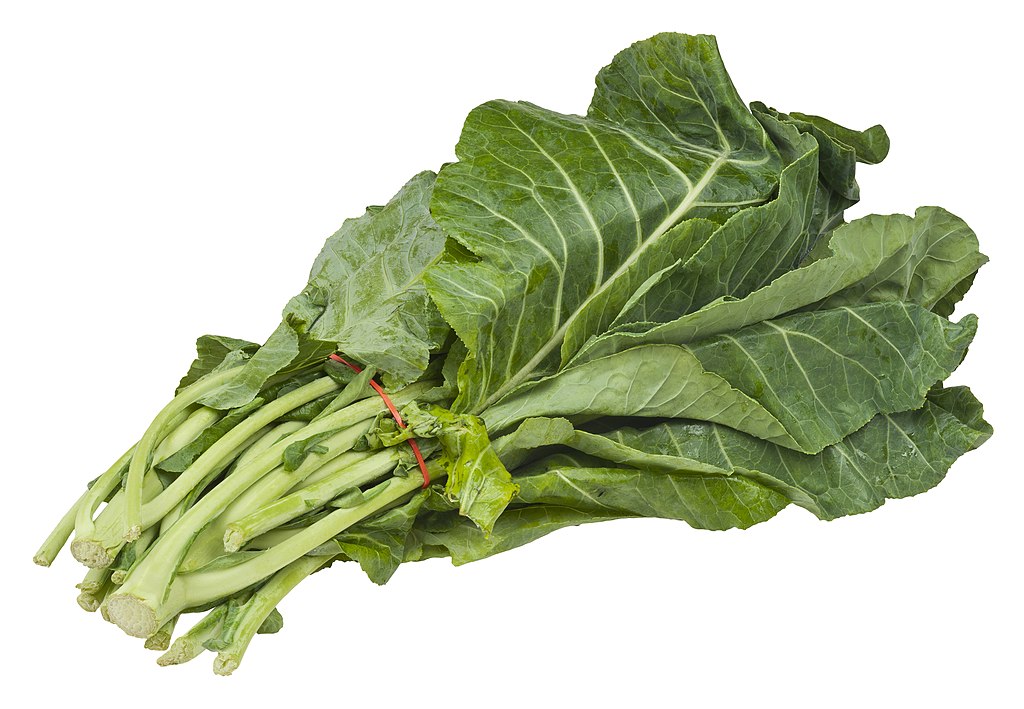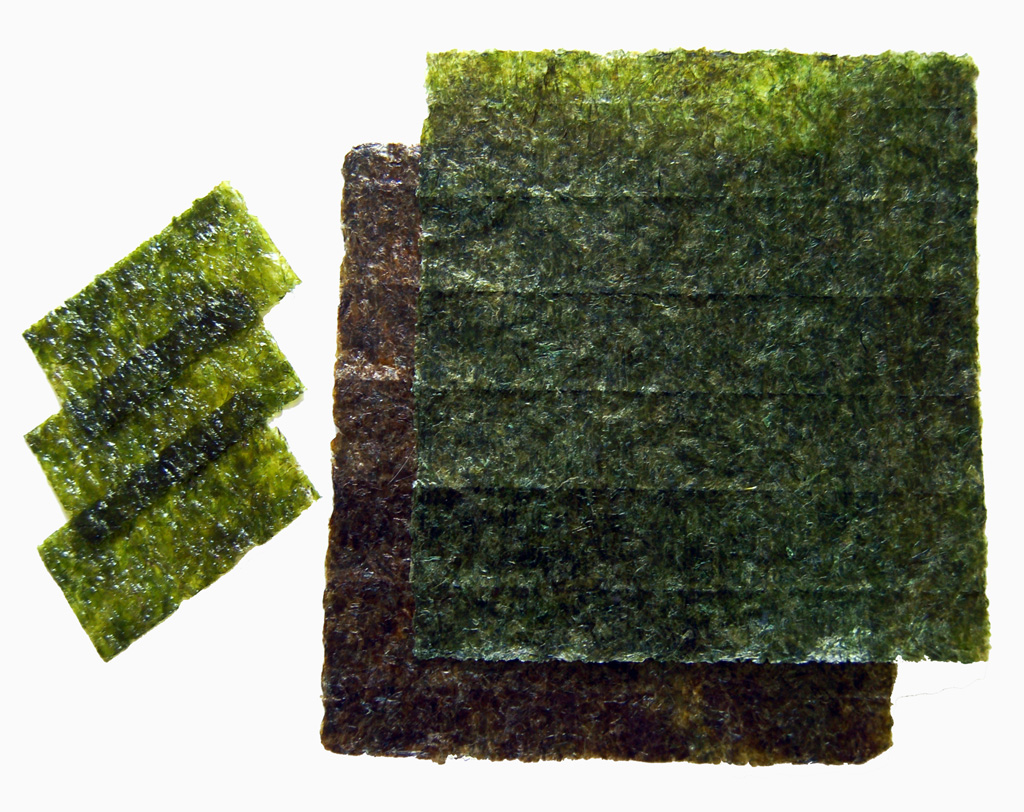Collard Greens vs. Nori
Nutrition comparison of Collard Greens and Nori
Ever wonder how your favorite foods stack up against each other in terms of nutrition?
We compared the nutritional contents of
collard greens
versus
nori
(100g each)
below using 2020 USDA and NIH data[1].
For a quick recap of significant nutrients and differences in collard greens and nori:
- Both nori and collard greens are high in Vitamin A, Vitamin C, calcium and potassium.
- Collard green is an excellent source of Vitamin K and dietary fiber.
- Nori has more riboflavin and niacin.
USDA sources for nutritional information: Collard Greens (Collards, raw) and Nori (Seaweed, laver, raw) . Have a correction or suggestions? Shoot us an email.
Calories and Carbs
calories
Nori and collard greens contain similar amounts of calories - nori has 35 calories per 100 grams and collard green has 32 calories.
For macronutrient ratios, collard greens is much lighter in protein, much heavier in carbs and heavier in fat compared to nori per calorie. Collard greens has a macronutrient ratio of 31:56:13 and for nori, 67:33:0 for protein, carbohydrates and fat from calories.
Macro Ratios from Calories:
| Collard Greens | Nori | |
|---|---|---|
| Protein | 31% | 67% |
| Carbohydrates | 56% | 33% |
| Fat | 13% | ~ |
| Alcohol | ~ | ~ |
carbohydrates
Nori and collard greens contain similar amounts of carbs - nori has 5.1g of total carbs per 100 grams and collard green has 5.4g of carbohydrates.
dietary fiber
Collard green is an excellent source of dietary fiber and it has 12 times more dietary fiber than nori - nori has 0.3g of dietary fiber per 100 grams and collard green has 4g of dietary fiber.
sugar
Nori and collard greens contain similar amounts of sugar - nori has 0.49g of sugar per 100 grams and collard green has 0.46g of sugar.
Protein
protein
Nori has 92% more protein than collard green - nori has 5.8g of protein per 100 grams and collard green has 3g of protein.
Fat
saturated fat
Both nori and collard greens are low in saturated fat - nori has 0.06g of saturated fat per 100 grams and collard green has 0.06g of saturated fat.
Vitamins
Vitamin C
Both nori and collard greens are high in Vitamin C. Nori has a little more Vitamin C (10%) than collard green by weight - nori has 39mg of Vitamin C per 100 grams and collard green has 35.3mg of Vitamin C.
Vitamin A
Both nori and collard greens are high in Vitamin A. Nori has a little more Vitamin A (4%) than collard green by weight - nori has 260ug of Vitamin A per 100 grams and collard green has 251ug of Vitamin A.
Vitamin E
Nori and collard greens contain similar amounts of Vitamin E - nori has 1mg of Vitamin E per 100 grams and collard green has 2.3mg of Vitamin E.
Vitamin K
Collard green is an excellent source of Vitamin K and it has 108 times more Vitamin K than nori - nori has 4ug of Vitamin K per 100 grams and collard green has 437.1ug of Vitamin K.
The B Vitamins
Nori has more riboflavin and niacin. Both collard greens and nori contain significant amounts of thiamin, pantothenic acid, Vitamin B6 and folate.
| Collard Greens | Nori | |
|---|---|---|
| Thiamin | 0.054 MG | 0.098 MG |
| Riboflavin | 0.13 MG | 0.446 MG |
| Niacin | 0.742 MG | 1.47 MG |
| Pantothenic acid | 0.267 MG | 0.521 MG |
| Vitamin B6 | 0.165 MG | 0.159 MG |
| Folate | 129 UG | 146 UG |
Minerals
calcium
Both nori and collard greens are high in calcium. Collard green has 231% more calcium than nori - nori has 70mg of calcium per 100 grams and collard green has 232mg of calcium.
iron
Nori has 283% more iron than collard green - nori has 1.8mg of iron per 100 grams and collard green has 0.47mg of iron.
potassium
Both nori and collard greens are high in potassium. Nori has 67% more potassium than collard green - nori has 356mg of potassium per 100 grams and collard green has 213mg of potassium.
Antioxidants and Phytonutrients
carotenoids
Carotenoids are micronutrients commonly found in plants and some animal products. An example is beta-carotene, the notable carotenoid which is a popular source of Vitamin A.[4][5]
For specific types of carotenoids, both collard greens and nori contain significant amounts of beta-carotene.
| Collard Greens | Nori | |
|---|---|---|
| beta-carotene | 2991 UG | 3121 UG |
| alpha-carotene | 14 UG | ~ |
| lutein + zeaxanthin | 4323 UG | ~ |
Omega-3 and Omega-6
omega 3s
For omega-3 fatty acids, collard green has more alpha linoleic acid (ALA) than nori per 100 grams, however, nori contains more epa than collard green per 100 grams.
| Collard Greens | Nori | |
|---|---|---|
| alpha linoleic acid | 0.108 G | 0.001 G |
| EPA | ~ | 0.08 G |
| Total | 0.108 G | 0.081 G |
omega 6s
Comparing omega-6 fatty acids, collard green has more linoleic acid than nori per 100 grams.
| Collard Greens | Nori | |
|---|---|---|
| linoleic acid | 0.082 G | 0.004 G |
| other omega 6 | 0.002 G | 0.009 G |
| Total | 0.084 G | 0.013 G |
Customize your serving size
The comparison below is by common portions, e.g. cups, packages. You can also see a more concrete comparison by weight at equal weight (by grams) comparison.
Note: The specific food items compared are: Collard Greens (Collards, raw) and Nori (Seaweed, laver, raw) .
Collard Greens g
()
|
Daily Values (%) |
Nori g
()
|
|||||
|---|---|---|---|---|---|---|---|
| KCAL % |
|
5% | calories | 5% |
|
KCAL % | |
| G % |
|
5% | carbohydrates | 5% |
|
G % | |
| G % |
|
5% | dietary fiber | 5% |
|
G % | |
| G | 5% | sugar | 5% | G | |||
| G % |
|
5% | total fat | 5% |
|
G % | |
| G % |
|
5% | saturated fat | 5% |
|
G % | |
| G | 5% | monounsaturated fat | 5% | G | |||
| G | 5% | polyunsaturated fat | 5% | G | |||
| G | 5% | trans fat | 5% | G | |||
| MG | 5% | cholesterol | 5% | MG | |||
| MG % |
|
5% | sodium | 5% |
|
MG % | |
| 5% | Vitamins and Minerals | 5% | |||||
| UG % |
|
5% | Vitamin A | 5% |
|
UG % | |
| MG % |
|
5% | Vitamin C | 5% |
|
MG % | |
| IU % |
|
5% | Vitamin D | 5% |
|
IU % | |
| MG % |
|
5% | calcium | 5% |
|
MG % | |
| MG % |
|
5% | iron | 5% |
|
MG % | |
| MG % |
|
5% | magnesium | 5% |
|
MG % | |
| MG % |
|
5% | potassium | 5% |
|
MG % | |
| MG % |
|
5% | thiamin (Vit B1) | 5% |
|
MG % | |
| MG % |
|
5% | riboflavin (Vit B2) | 5% |
|
MG % | |
| MG % |
|
5% | niacin (Vit B3) | 5% |
|
MG % | |
| MG % |
|
5% | Vitamin B6 | 5% |
|
MG % | |
| MG % |
|
5% | pantothenic acid (Vit B5) | 5% |
|
MG % | |
| UG % |
|
5% | folate (Vit B9) | 5% |
|
UG % | |
| UG % |
|
5% | Vitamin B12 | 5% |
|
UG % | |
| MG % |
|
5% | Vitamin E | 5% |
|
MG % | |
| UG % |
|
5% | Vitamin K | 5% |
|
UG % | |
| G % |
|
5% | protein | 5% |
|
G % | |
| UG % |
|
5% | biotin (Vit B7) | 5% |
|
UG % | |
| MG % |
|
5% | choline | 5% |
|
MG % | |
| MG % |
|
5% | chlorine | 5% |
|
MG % | |
| UG % |
|
5% | chromium | 5% |
|
UG % | |
| MG % |
|
5% | copper | 5% |
|
MG % | |
| UG % |
|
5% | fluoride | 5% |
|
UG % | |
| UG % |
|
5% | iodine | 5% |
|
UG % | |
| MG % |
|
5% | manganese | 5% |
|
MG % | |
| UG % |
|
5% | molybdenum | 5% |
|
UG % | |
| MG % |
|
5% | phosphorus | 5% |
|
MG % | |
| UG % |
|
5% | selenium | 5% |
|
UG % | |
| MG % |
|
5% | zinc | 5% |
|
MG % | |
| G | 5% | Water | 5% | G | |||
| G | 5% | Starch | 5% | G | |||
| G | 5% | Alcohol | 5% | G | |||
FAQ
Does nori or collard greens contain more calories in 100 grams?Nori and collard greens contain similar amounts of calories - nori has 35 calories in 100g and collard green has 32 calories.
Is nori or collard greens better for protein?
Nori has 90% more protein than collard green - nori has 5.8g of protein per 100 grams and collard green has 3g of protein.
Does nori or collard greens have more carbohydrates?
By weight, nori and collard greens contain similar amounts of carbs - nori has 5.1g of carbs for 100g and collard green has 5.4g of carbohydrates.
Does nori or collard greens contain more calcium?
Both nori and collard greens are high in calcium. Collard green has 230% more calcium than nori - nori has 70mg of calcium in 100 grams and collard green has 232mg of calcium.
Does nori or collard greens contain more potassium?
Both nori and collard greens are high in potassium. Nori has 70% more potassium than collard green - nori has 356mg of potassium in 100 grams and collard green has 213mg of potassium.

